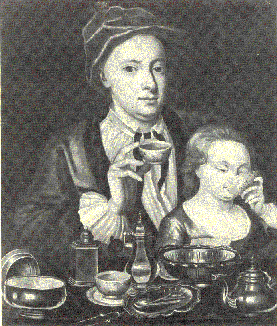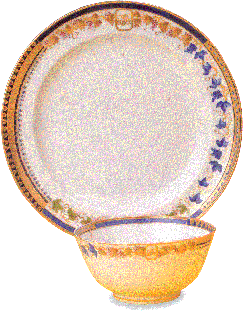TEA CEREMONY
Tea Porcelain Home

Tea Party (c.1725)
TEA
To the top . . .
"I drink and kindly streams arise Wine's vapour flags, and soon subsides and dies, The friendly Sprits brighten mine again, Repel the Brute, and re-inthrone the Man. The pleasing Charmer with a Pleasing Ray Dawns on the Mind, introduces Day. So its parent with presenting light, Recalls Distinction, and displaces Night."2
According to Chinese legend, tea was first tried by the Emperor Shen Nung sometime around 2000 B.C. The tea that he drank was supposedly brought to him by a group of explorers who had gone to the mountainous area of Yunnan, which is close to the Chinese border with Assam. The fragrance, the taste, and the refreshing effects of tea attracted Chinese nobles in the court, and thus it became a favorite drink amongst the Chinese.
Tea was also received well by Buddhist monks, who were prohibited from taking alcohol and found tea to be a worthy substitute because it contained caffeine and tannin- it had a comfortably stimulating awakening effect. There is actually a story of a legendary Buddhist patriarch who devoted himself to seven years of sleepless meditation, and who was the first person to use tea in order to keep himself awake.
Tea at this early stage was not served the way we know it to be today. A Chinese document of the 3rd century A.D. explains that tea leaves were pressed like a brick; and when it was served, it had to be crushed and mixed with onion, ginger, orange, and other spices, and then hot water was poured over the concoction.8 Tea was used at this stage for medicinal purposes rather than an ordinary beverage. But no matter who actually discovered tea, there is absolutely no doubt that the Chinese were the tea drinkers who first started the habit thousands of years ago.
Tea was first drunk for pleasure in ancient China at the time of the Han dynasty (206-220 B.C.).9 Tea was originally made in bowls, but pots were introduced in the Song dynasty (AD 970-1279), and both tea and teapots began to arrive in the West in the 1650?s. The new beverage became very popular, and very fast- it was made in small teapots and served in tiny cups due to the insane price of tea, but once the prices fell, tea cups grew accordingly.
How did tea ever get from China to Great Britain? In the following centuries, tea became a necessary accompaniment to social gatherings, and it offered a way to have more sophisticated and intellectual discussions.9 Scholars, high-ranking officials, and monks would all gather together with a cup of tea and hang out while enjoying the most philosophical discussions for hours upon hours. The Emperor during the 5th century owned the best tea garden in the country, and drinking a good cup of tea became an obvious status symbol.
The Arabs had known about tea as a drink as early as the 9th century. In central Asia, tea was brought from China during the Tang dynasty (7th century); it was given to the nomads of Tibet and Mongolia. Tea was a great source of vitamin C, and these nomads were unable to find green vegetables in the plains of central Asia. As a matter of fact, the Chinese government during the Ming and Ching dynasties was able to manipulate these threatening people by trading tea with them.
In comparison with the Asians, from Arabs to Japanese, westerners learned to appreciate the value of tea much later. The first record of tea in the West is found within the writings of Giambattista Ramusio, who found this new beverage called "Chai Catai" after visiting the Near East. In his work, "Navigationi e Viaggi," (published in 1559) he wrote, "They take of that herb, whether dry or fresh, and boil it in water. One or two cups of this decoction taken on an empty stomach removes fever, headache, stomach-ache, pain in the side or in the joints, and it should be taken as you can bear it."
Like some of their Eastern friends, the Buddhist monks, the Jesuits grew to like tea- they found it to be a good substitute for alcohol. It should also be noted that the 15th and 16th centuries was a period when Europe began to learn about Asia by means of the Arabs (outer sea navigation was brought by the Arabs). The crossroads between the East and West actually existed in Baghdad. Tea was in this sense, one of the earliest and the most important mediums for bringing two worlds together- the trade of tea expanded intercultural communication.
The first tea export from China to Europe took place in 1606 in Bantam, Java where traders brought tea from China to be shipped to Holland by the Dutch East India Company. Naturally, like any other new product, it took time for tea to become popular in Europe. By the middle of the 17th century, however, tea was a very fashionable item in Paris. Of course though, the people who took the most liking to tea were the British. The first advertisement for tea (then called Tcha, Tay, or Tee) appeared in the British weekly magazine "Mercurius Politicus" in September of 1658. The advertisement stated that this crazy new import from China was excellent and was approved by all doctors- this started the beginning of a tea frenzy in Britain. Within a few years tea had become popular with the higher class Dutch population. It was at the time very expensive and only sold in medicine shops. By 1675 though, tea could be purchased in food stores. The wealthy people built special tea rooms in their houses and the women organized tea clubs. Its funny to note one tea authority of the time who stated: "The craze for tea parties finally resulted in the ruin of many homes."8 He thought that women were neglecting their responsibilities as women; and as a result, the men were having to seek solace in the taverns.
The Dutch and British brought tea to London in the 1650?s and coffee houses became popular meeting places where men could meet their friends for a drink and discuss the news of the day. These coffee houses later became the gentleman?s clubs that we know of today. Especially after its colonial expansion to India and Sri Lanka (Ceylon), Great Britain became successful in establishing tea plantations, and London quickly became the heart of the tea trade from the turn of the 19th century on. It?s also interesting to note that, in order to facilitate faster tea transportation from China to London, the British built "tea clippers" and competed with each other in speed.
Tea, the most "English" of drinks, actually originated in China and became popular as an export because of royal patronage. Tea entered the British scene in the 17th century: the first recorded instance of the word "tea" appears in 1615. After its introduction, the popularity of tea grew in leaps and bounds. If in 1700 only 20,00 pounds of tea were imported, then by 1721 that number exceed 1 million pounds. Between 1721 and 1760 the total quantity of tea consumption increased by five-fold.2
The association of tea with both femininity and upper-class began with a single royal marriage: that of Portugese princess Catherine Braganza and Charles II. Her dowry included five hundred pounds sterling, possession of Tangiers, the right to free trade with Brazil, the East Indies, and the "island of Bombay." She is considered responsible for introducing tea to the court, and, more importantly, her marriage secured England's domain over the eastern trading routes and helped usher in England's "first empire:" that is, the East India Company. Edmund Waller wrote, "Of Tea, commended is her majesty.... she showed [us] the fair region, where the Sun does rise."2
The most common types of tea imported from China in the 17th and at the beginning of the 18th century were green, unfermented teas, such as the oddly named Hyson Skin, Bing, and Caper. As the eighteenth century progressed, enthusiasm grew for black teas, such as Black Souchong and Congou and the most expensive, Pekoe. The only tea not consumed by the British public was the tea reserved for the Chinese emperor and high court: the leaves which it contained were so high up that monkeys were used to pick them. This was known as "Imperial Monkey-Picked Tea."
The tea pot was created when the Chinese added a handle and spout to their wine pot, spawning English imitators. 1There is a certain irony in the evolution, as one of the qualities the British praised in tea was the anti-alcohol. Edmund Waller praised tea as "the best of herbs... it represses those vapours upon which the head invade and keeps the palace of the soul serene."2
Attitudes toward tea were not only enthusiastic: the craze for tea that rose among the population also provoked a certain degree of ambivalence. Some worried that money that should be spent towards strengthening military power was being wasted in the acquisition of tea. Others claimed that the use of tea in poor families caused malnutrition, because vegetable purchases were omitted in favor of tea. There seems to be a definite class bias in these attitudes. Wealthy women were encouraged to serve and consume tea: the ceremony itself gave them the opportunity to display their grace, femininity, and competence.2 Mary Braddon said in her play Lady Audley's Secret that "the most feminine and most domestic of all occupations imparts a magic harmony to her every movement, a witchery to her every glance... At the table she reigns omnipotent, unapproachable. To do away with the tea table is to rob woman of her legitimate empire."2 Women bleached their hands to a greater whiteness with arsenic, and Josiah Wedgewood even created black tea sets to set off the whiteness of a lady's hands. Poor women, on the other hand, were frowned upon as self-indulgent and neglectful if they spent valuable time and resources on tea.
After the loss of the monopoly on India in 1816, the East India Company committee decided the monopoly on tea hindered wider development of trading in the east. After this verdict in 1833, anyone could trade tea.1
PORCELAIN
To the top . . .
 Chinese Porcelain |
While porcelain and so called "chinaware" exploded in the British home in the 18th century, the porcelain trade comprised only two percent of the East India Company's china trade. "China fever" that spread through England was not unique to a single class or even to woman. Chinaware was appealing in its ability to be both an aesthetic item and an item for everyday use. As one of the women working out Orphan's Court Inventories, Laura Wetheril remarked that "china?changed from being unknown in 1675 to being a normal part of household equipment by 1715." To have chinaware at one's table indicated a kind of sophistication or worldliness.
Porcelain went through three faces of production. Initially, Chinese craftsmen made western-shaped pottery with Chinese decorations, using blue-and-white, kraak, and rolwagen ware. As time progressed, however, craftsmen made porcelain goods entirely according to Western standards, such as Imari ware and figurines. When the re-demand for Chinese-type goods, or "Chinoiserie" rose later in the century, British artisans created their own version of chinaware. These pieces were characterized by an styles based on western fantasies of China rather than authentic depictions of Chinese decorative arts. After 1729 the English were supplying much of the chinaware demand themselves. Pieces exported from china were usually made-to-order to commemorate special events, or were special items such as giant Mandarin vases, elaborate pagodas, and ginger jars. Ginger would also make its way into the English kitchen. |